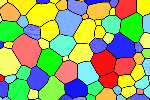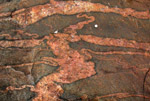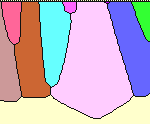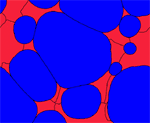- The formation of veins and their microstructures
- Numerical modelling of microstructures
- Melt segregation, accumulation, ascent & SOC (Self-Organised Criticality)
- Cap de Creus (Spain) and apparent boudinage
Currently funded projects
- 2005-2006: Numerical modelling of partial-melt microstructures (DFG BO-1776/3)
- 2005-2008: Knowledge-based materials - learning from nature (Marie Curie Summer Schools)
- 2006-2008: 3D modelling of polycrystalline substructure development, with particular emphasis on ice and NaCl (An ESF-Eurocores project, part of the EuroMinSci Network "Substructure Development", DFG BO-1776/4)
The formation of veins and their microstructures

|
Ongoing
reasearch
into how mineral veins form and what (micro-) structures develop. Field
studies were mainly carried out in Australia, near Arkaroola (fibrous
antitaxial
calcite veins) and Poolamacca Station (large massive quartz veins), but
is now getting extended to other locations, such as Lourdes and
Cadaqués
in the Pyrenees. One of the recent developments is the discovery of ca.
585 Ma fossil microbes that lived in carbonate veins, a few km deep.
Main methods are field observations, thin section analysis, numerical
modelling and scanning electron microscopy.
Current collaborators: Marlina Elburg (Gent, Belgium), Ronald Bakker (Leoben, Austria), Chris Hilgers, Sofie Nollet, Janos Urai (Aachen, Germany), Daniel Koehn, Cees Passchier (Mainz, Germany) Selected publications (see publications for full listing of all papers):
|
Numerical modelling of microstructures
| The aim of
numerical modelling
of microstructures is to better understand the formation mechanisms of
microstructures and, conversely, to improve their interpretation. The
main
project is ELLE,
which is a multinational collaboration to develop a micro-process based
modelling platform to simulate microstructural development when
multiple
interacting and coupled deformation and metamorphic processes operate.
A second line of this research is the modelling of vein and pressure
fringe
structures. Current collaborators: the ELLE-Team, in particular Mark Jessell (Toulouse, France), Daniel Koehn (Mainz, Germany) and Lynn Evans (Melbourne, Australia) Selected publications (see publications for full listing of all papers):
|
 
|
Melt segregation, accumulation, ascent & SOC (Self-Organised Criticality)

|
The step
between initial segregation
of melt to transport of accumulated melt is maybe the least understood
one in the chain of processes from melting to magma emplacement.
Research
ranges from field work on migmatites (South Finland), to numerical
modelling
and analogue experiments (PhD project Nico Walte, Mainz). Particular
attention is given to self-organisation
and establishment of self-organised critical states in these complex
systems.
Current collaborators: Marlina Elburg (Gent, Belgium), Alvar Soesoo (Tallinn, Estonia), Boudewijn van Milligen (Madrid, Spain) Selected publications (see publications for full listing of all papers):
|
Cap de Creus (Spain) and apparent boudinage
|
Boudinage is
a classical structure
that indicates stretching of a competent layer. However, field studies
in NW Australia and currently at Cap de Creus (NE Spain), have shown
that
sometimes structures can form that look remarkably similar to real
boudins,
but that did not form by stretching of the layer. In migmatites this
may
occur when melt is removed from the system, leading to boudin-neck like
collapse structures. Dykes may be divided into strings of blobs or
"beads"
upon emplacement, while the intruded magma is not yet fully
crystallised.
These structures, which are abundant at Cap de Creus can easily be
mistook
for boudins. They have also been found in Finland and Namibia.
Apart from the apparant boudinage, Cap de Creus has a fascinating and complex geology, ideal for structural geological field exercise. Current
collaborators: Elena Druguet and Jordi Carreras (Barcelona, Spain) and
Cees Passchier (Mainz, Germany)
|

|
update: 02/2005





